Vodafone: Macro Environment, Strategy, and Competitive Edge Report
VerifiedAdded on 2020/10/05
|12
|4294
|146
Report
AI Summary
This report provides a comprehensive analysis of Vodafone's business strategy, focusing on the macro environment, internal capabilities, and strategic planning. It begins with an examination of the macro environment, including political, economic, social, technological, legal, and environmental factors, and how these influence Vodafone's strategic decisions. The report then evaluates Vodafone's strengths and weaknesses using tools like VRIO analysis. Furthermore, it explores strategies for improving market position and achieving a competitive edge, including the application of Ansoff's growth matrix. Finally, the report culminates in a strategic management plan outlining strategic objectives and priorities for Vodafone. The analysis underscores the importance of adapting to the telecommunications industry's competitive dynamics and leveraging internal resources effectively.
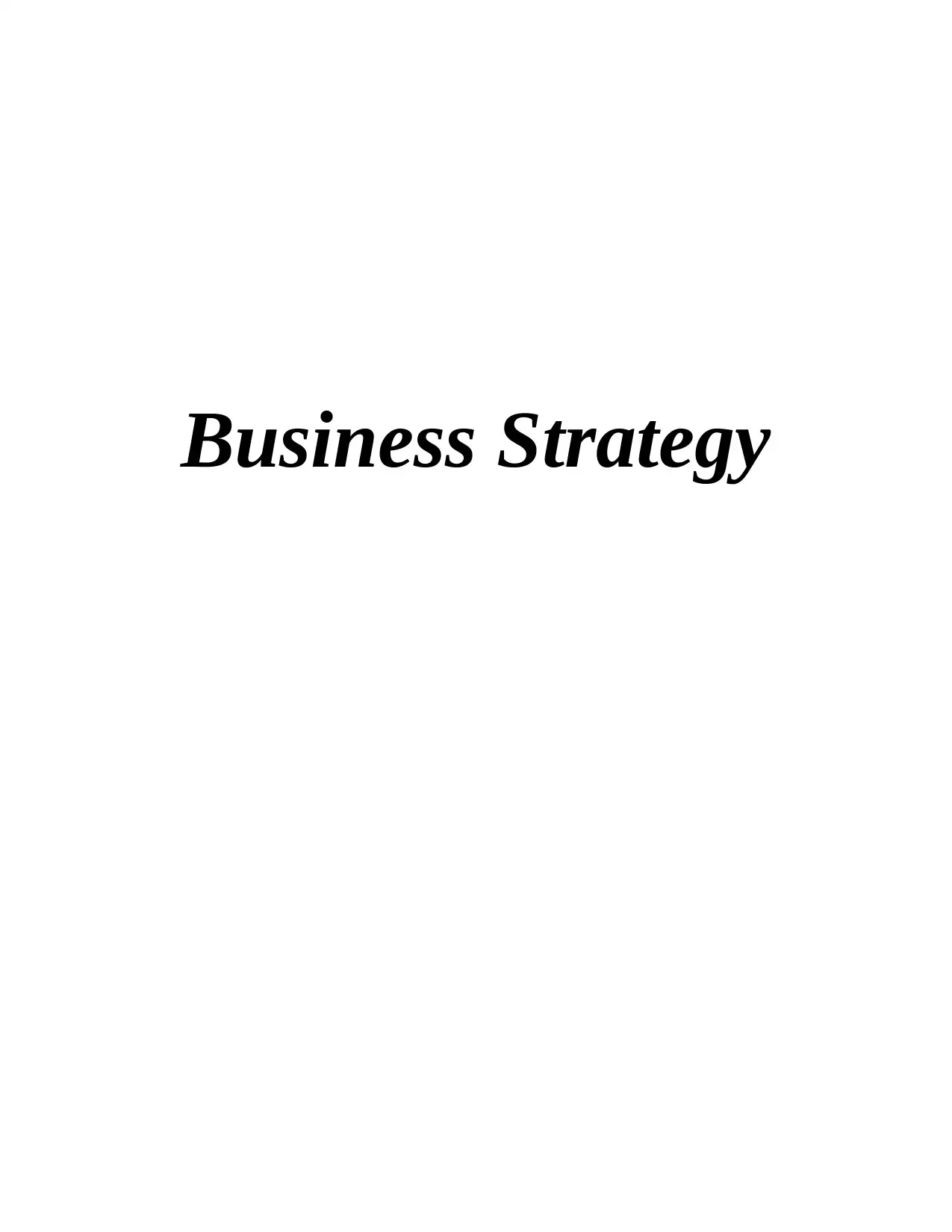
Business Strategy
Paraphrase This Document
Need a fresh take? Get an instant paraphrase of this document with our AI Paraphraser
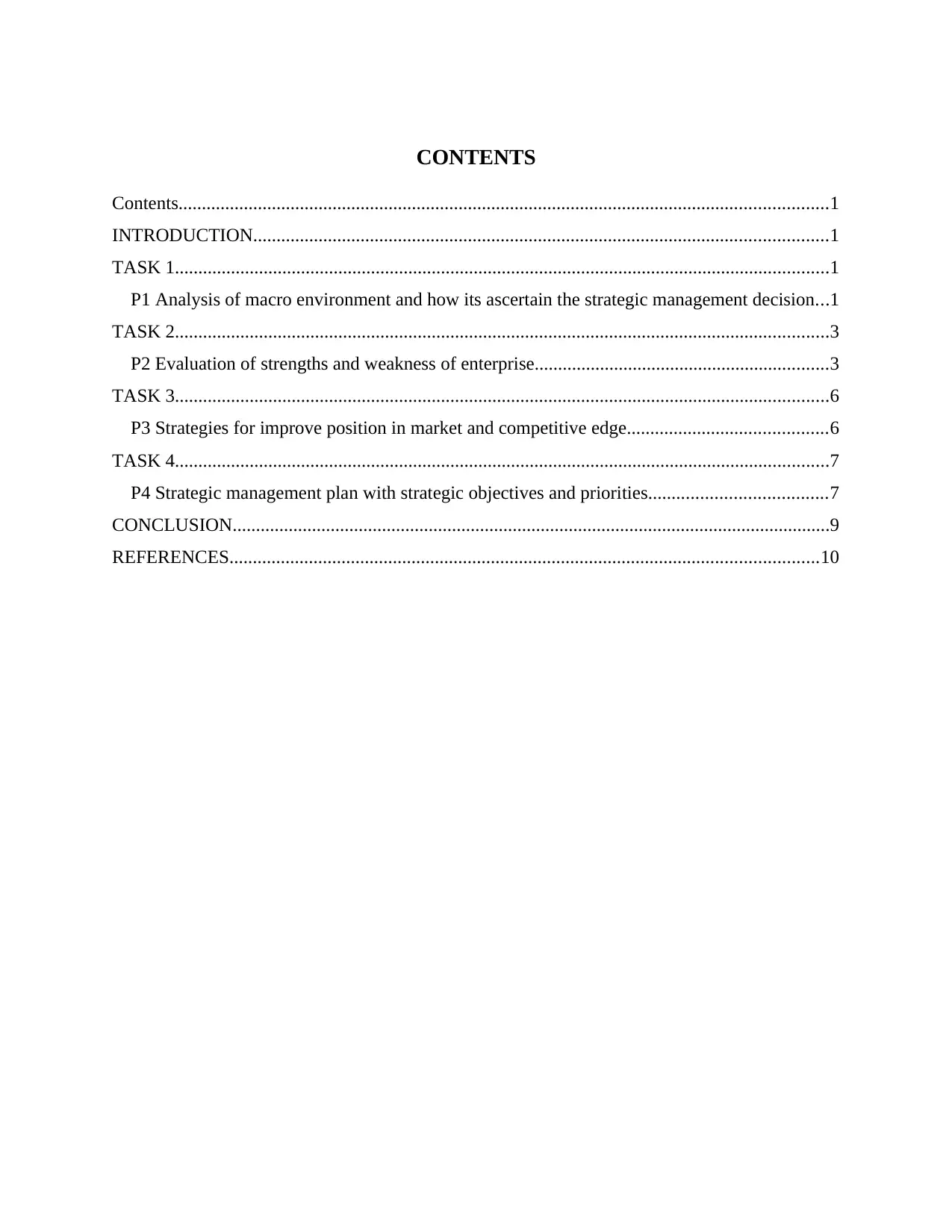
CONTENTS
Contents...........................................................................................................................................1
INTRODUCTION...........................................................................................................................1
TASK 1............................................................................................................................................1
P1 Analysis of macro environment and how its ascertain the strategic management decision...1
TASK 2............................................................................................................................................3
P2 Evaluation of strengths and weakness of enterprise...............................................................3
TASK 3............................................................................................................................................6
P3 Strategies for improve position in market and competitive edge...........................................6
TASK 4............................................................................................................................................7
P4 Strategic management plan with strategic objectives and priorities......................................7
CONCLUSION................................................................................................................................9
REFERENCES..............................................................................................................................10
Contents...........................................................................................................................................1
INTRODUCTION...........................................................................................................................1
TASK 1............................................................................................................................................1
P1 Analysis of macro environment and how its ascertain the strategic management decision...1
TASK 2............................................................................................................................................3
P2 Evaluation of strengths and weakness of enterprise...............................................................3
TASK 3............................................................................................................................................6
P3 Strategies for improve position in market and competitive edge...........................................6
TASK 4............................................................................................................................................7
P4 Strategic management plan with strategic objectives and priorities......................................7
CONCLUSION................................................................................................................................9
REFERENCES..............................................................................................................................10
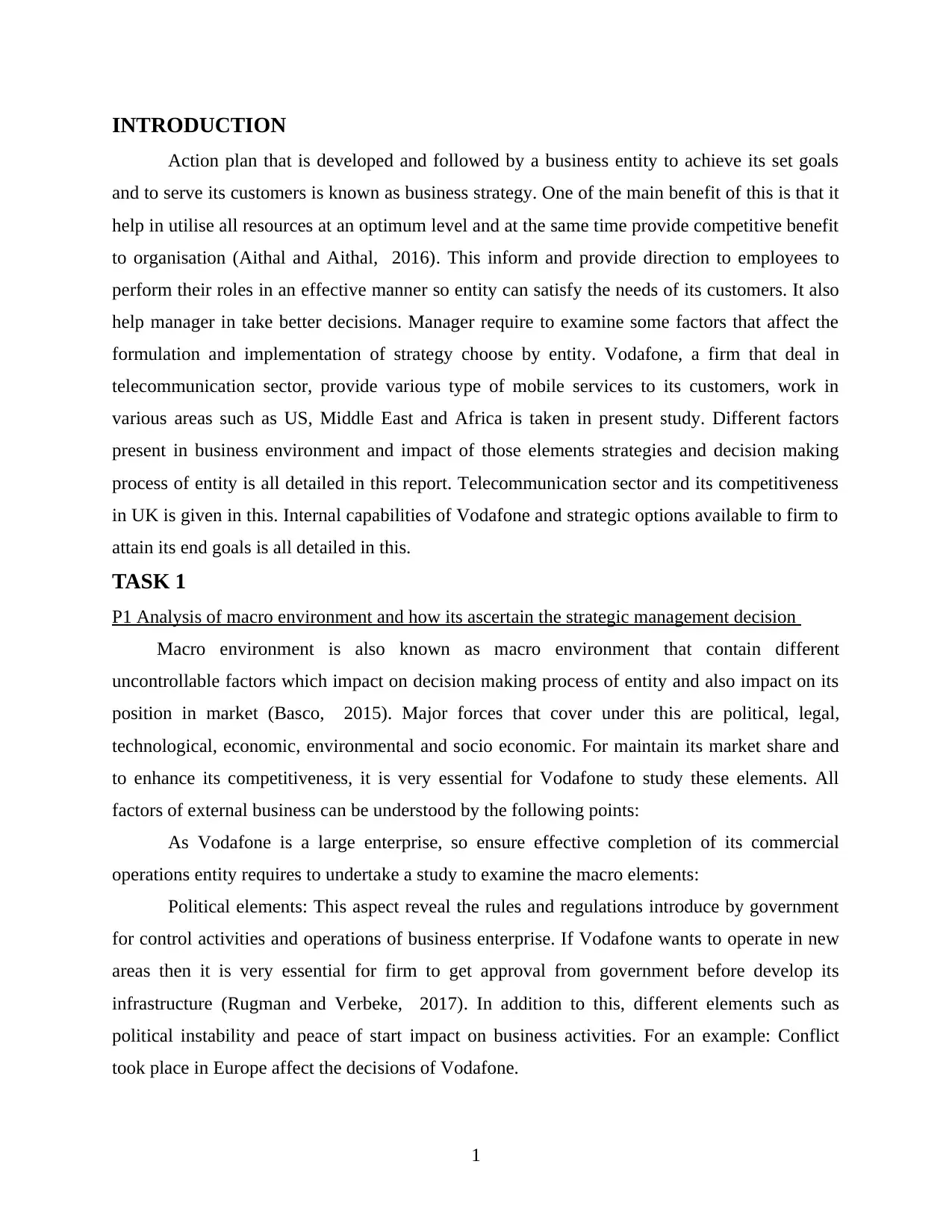
INTRODUCTION
Action plan that is developed and followed by a business entity to achieve its set goals
and to serve its customers is known as business strategy. One of the main benefit of this is that it
help in utilise all resources at an optimum level and at the same time provide competitive benefit
to organisation (Aithal and Aithal, 2016). This inform and provide direction to employees to
perform their roles in an effective manner so entity can satisfy the needs of its customers. It also
help manager in take better decisions. Manager require to examine some factors that affect the
formulation and implementation of strategy choose by entity. Vodafone, a firm that deal in
telecommunication sector, provide various type of mobile services to its customers, work in
various areas such as US, Middle East and Africa is taken in present study. Different factors
present in business environment and impact of those elements strategies and decision making
process of entity is all detailed in this report. Telecommunication sector and its competitiveness
in UK is given in this. Internal capabilities of Vodafone and strategic options available to firm to
attain its end goals is all detailed in this.
TASK 1
P1 Analysis of macro environment and how its ascertain the strategic management decision
Macro environment is also known as macro environment that contain different
uncontrollable factors which impact on decision making process of entity and also impact on its
position in market (Basco, 2015). Major forces that cover under this are political, legal,
technological, economic, environmental and socio economic. For maintain its market share and
to enhance its competitiveness, it is very essential for Vodafone to study these elements. All
factors of external business can be understood by the following points:
As Vodafone is a large enterprise, so ensure effective completion of its commercial
operations entity requires to undertake a study to examine the macro elements:
Political elements: This aspect reveal the rules and regulations introduce by government
for control activities and operations of business enterprise. If Vodafone wants to operate in new
areas then it is very essential for firm to get approval from government before develop its
infrastructure (Rugman and Verbeke, 2017). In addition to this, different elements such as
political instability and peace of start impact on business activities. For an example: Conflict
took place in Europe affect the decisions of Vodafone.
1
Action plan that is developed and followed by a business entity to achieve its set goals
and to serve its customers is known as business strategy. One of the main benefit of this is that it
help in utilise all resources at an optimum level and at the same time provide competitive benefit
to organisation (Aithal and Aithal, 2016). This inform and provide direction to employees to
perform their roles in an effective manner so entity can satisfy the needs of its customers. It also
help manager in take better decisions. Manager require to examine some factors that affect the
formulation and implementation of strategy choose by entity. Vodafone, a firm that deal in
telecommunication sector, provide various type of mobile services to its customers, work in
various areas such as US, Middle East and Africa is taken in present study. Different factors
present in business environment and impact of those elements strategies and decision making
process of entity is all detailed in this report. Telecommunication sector and its competitiveness
in UK is given in this. Internal capabilities of Vodafone and strategic options available to firm to
attain its end goals is all detailed in this.
TASK 1
P1 Analysis of macro environment and how its ascertain the strategic management decision
Macro environment is also known as macro environment that contain different
uncontrollable factors which impact on decision making process of entity and also impact on its
position in market (Basco, 2015). Major forces that cover under this are political, legal,
technological, economic, environmental and socio economic. For maintain its market share and
to enhance its competitiveness, it is very essential for Vodafone to study these elements. All
factors of external business can be understood by the following points:
As Vodafone is a large enterprise, so ensure effective completion of its commercial
operations entity requires to undertake a study to examine the macro elements:
Political elements: This aspect reveal the rules and regulations introduce by government
for control activities and operations of business enterprise. If Vodafone wants to operate in new
areas then it is very essential for firm to get approval from government before develop its
infrastructure (Rugman and Verbeke, 2017). In addition to this, different elements such as
political instability and peace of start impact on business activities. For an example: Conflict
took place in Europe affect the decisions of Vodafone.
1
⊘ This is a preview!⊘
Do you want full access?
Subscribe today to unlock all pages.

Trusted by 1+ million students worldwide
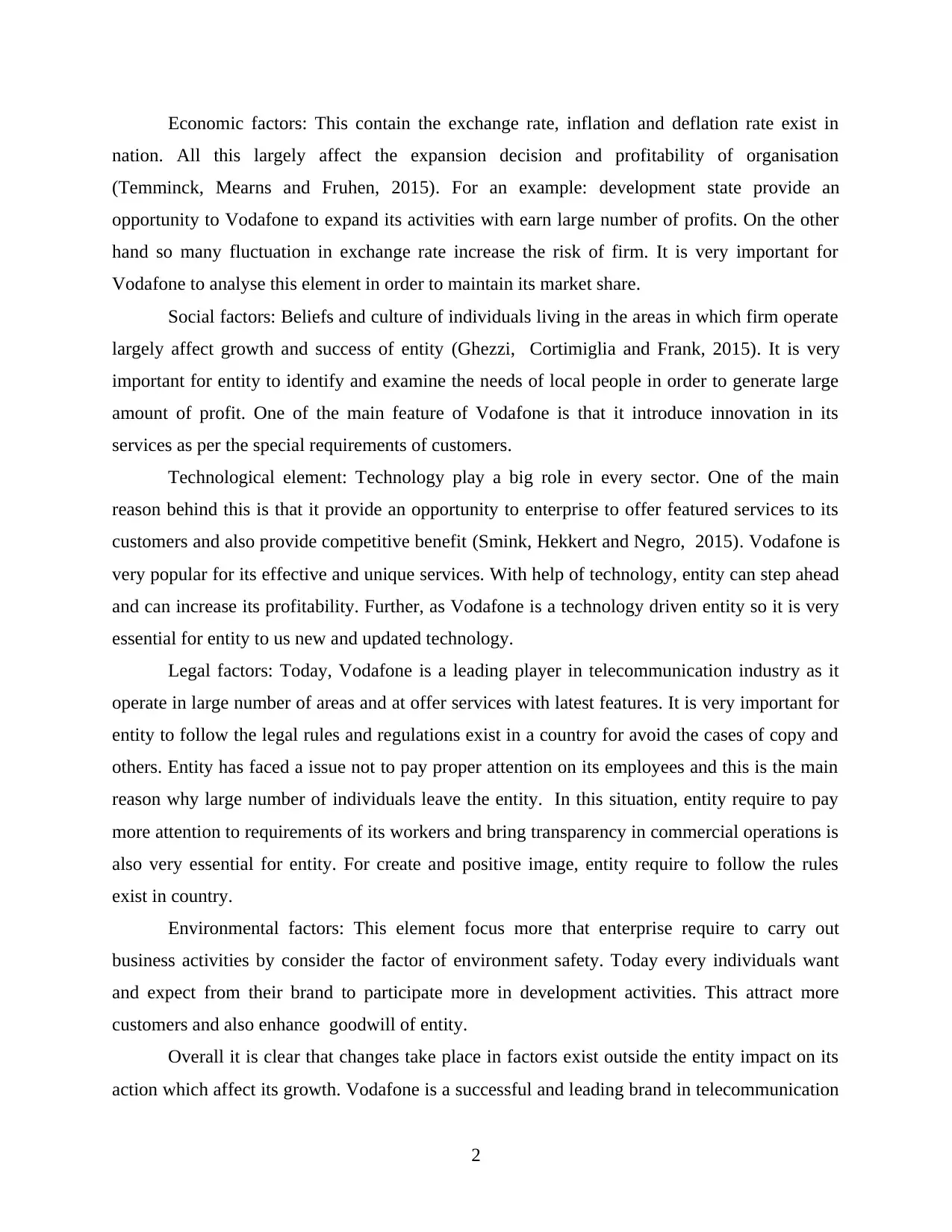
Economic factors: This contain the exchange rate, inflation and deflation rate exist in
nation. All this largely affect the expansion decision and profitability of organisation
(Temminck, Mearns and Fruhen, 2015). For an example: development state provide an
opportunity to Vodafone to expand its activities with earn large number of profits. On the other
hand so many fluctuation in exchange rate increase the risk of firm. It is very important for
Vodafone to analyse this element in order to maintain its market share.
Social factors: Beliefs and culture of individuals living in the areas in which firm operate
largely affect growth and success of entity (Ghezzi, Cortimiglia and Frank, 2015). It is very
important for entity to identify and examine the needs of local people in order to generate large
amount of profit. One of the main feature of Vodafone is that it introduce innovation in its
services as per the special requirements of customers.
Technological element: Technology play a big role in every sector. One of the main
reason behind this is that it provide an opportunity to enterprise to offer featured services to its
customers and also provide competitive benefit (Smink, Hekkert and Negro, 2015). Vodafone is
very popular for its effective and unique services. With help of technology, entity can step ahead
and can increase its profitability. Further, as Vodafone is a technology driven entity so it is very
essential for entity to us new and updated technology.
Legal factors: Today, Vodafone is a leading player in telecommunication industry as it
operate in large number of areas and at offer services with latest features. It is very important for
entity to follow the legal rules and regulations exist in a country for avoid the cases of copy and
others. Entity has faced a issue not to pay proper attention on its employees and this is the main
reason why large number of individuals leave the entity. In this situation, entity require to pay
more attention to requirements of its workers and bring transparency in commercial operations is
also very essential for entity. For create and positive image, entity require to follow the rules
exist in country.
Environmental factors: This element focus more that enterprise require to carry out
business activities by consider the factor of environment safety. Today every individuals want
and expect from their brand to participate more in development activities. This attract more
customers and also enhance goodwill of entity.
Overall it is clear that changes take place in factors exist outside the entity impact on its
action which affect its growth. Vodafone is a successful and leading brand in telecommunication
2
nation. All this largely affect the expansion decision and profitability of organisation
(Temminck, Mearns and Fruhen, 2015). For an example: development state provide an
opportunity to Vodafone to expand its activities with earn large number of profits. On the other
hand so many fluctuation in exchange rate increase the risk of firm. It is very important for
Vodafone to analyse this element in order to maintain its market share.
Social factors: Beliefs and culture of individuals living in the areas in which firm operate
largely affect growth and success of entity (Ghezzi, Cortimiglia and Frank, 2015). It is very
important for entity to identify and examine the needs of local people in order to generate large
amount of profit. One of the main feature of Vodafone is that it introduce innovation in its
services as per the special requirements of customers.
Technological element: Technology play a big role in every sector. One of the main
reason behind this is that it provide an opportunity to enterprise to offer featured services to its
customers and also provide competitive benefit (Smink, Hekkert and Negro, 2015). Vodafone is
very popular for its effective and unique services. With help of technology, entity can step ahead
and can increase its profitability. Further, as Vodafone is a technology driven entity so it is very
essential for entity to us new and updated technology.
Legal factors: Today, Vodafone is a leading player in telecommunication industry as it
operate in large number of areas and at offer services with latest features. It is very important for
entity to follow the legal rules and regulations exist in a country for avoid the cases of copy and
others. Entity has faced a issue not to pay proper attention on its employees and this is the main
reason why large number of individuals leave the entity. In this situation, entity require to pay
more attention to requirements of its workers and bring transparency in commercial operations is
also very essential for entity. For create and positive image, entity require to follow the rules
exist in country.
Environmental factors: This element focus more that enterprise require to carry out
business activities by consider the factor of environment safety. Today every individuals want
and expect from their brand to participate more in development activities. This attract more
customers and also enhance goodwill of entity.
Overall it is clear that changes take place in factors exist outside the entity impact on its
action which affect its growth. Vodafone is a successful and leading brand in telecommunication
2
Paraphrase This Document
Need a fresh take? Get an instant paraphrase of this document with our AI Paraphraser
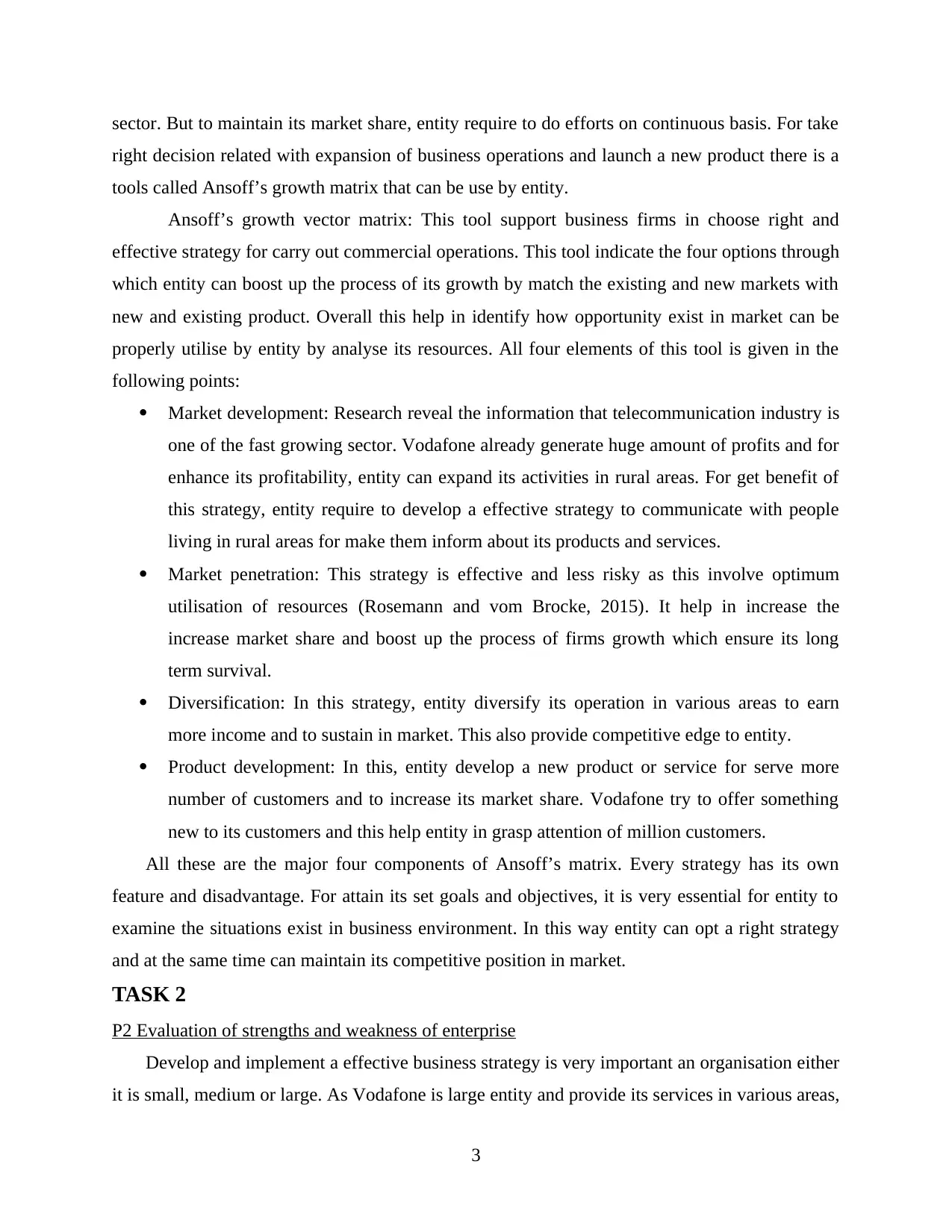
sector. But to maintain its market share, entity require to do efforts on continuous basis. For take
right decision related with expansion of business operations and launch a new product there is a
tools called Ansoff’s growth matrix that can be use by entity.
Ansoff’s growth vector matrix: This tool support business firms in choose right and
effective strategy for carry out commercial operations. This tool indicate the four options through
which entity can boost up the process of its growth by match the existing and new markets with
new and existing product. Overall this help in identify how opportunity exist in market can be
properly utilise by entity by analyse its resources. All four elements of this tool is given in the
following points:
Market development: Research reveal the information that telecommunication industry is
one of the fast growing sector. Vodafone already generate huge amount of profits and for
enhance its profitability, entity can expand its activities in rural areas. For get benefit of
this strategy, entity require to develop a effective strategy to communicate with people
living in rural areas for make them inform about its products and services.
Market penetration: This strategy is effective and less risky as this involve optimum
utilisation of resources (Rosemann and vom Brocke, 2015). It help in increase the
increase market share and boost up the process of firms growth which ensure its long
term survival.
Diversification: In this strategy, entity diversify its operation in various areas to earn
more income and to sustain in market. This also provide competitive edge to entity.
Product development: In this, entity develop a new product or service for serve more
number of customers and to increase its market share. Vodafone try to offer something
new to its customers and this help entity in grasp attention of million customers.
All these are the major four components of Ansoff’s matrix. Every strategy has its own
feature and disadvantage. For attain its set goals and objectives, it is very essential for entity to
examine the situations exist in business environment. In this way entity can opt a right strategy
and at the same time can maintain its competitive position in market.
TASK 2
P2 Evaluation of strengths and weakness of enterprise
Develop and implement a effective business strategy is very important an organisation either
it is small, medium or large. As Vodafone is large entity and provide its services in various areas,
3
right decision related with expansion of business operations and launch a new product there is a
tools called Ansoff’s growth matrix that can be use by entity.
Ansoff’s growth vector matrix: This tool support business firms in choose right and
effective strategy for carry out commercial operations. This tool indicate the four options through
which entity can boost up the process of its growth by match the existing and new markets with
new and existing product. Overall this help in identify how opportunity exist in market can be
properly utilise by entity by analyse its resources. All four elements of this tool is given in the
following points:
Market development: Research reveal the information that telecommunication industry is
one of the fast growing sector. Vodafone already generate huge amount of profits and for
enhance its profitability, entity can expand its activities in rural areas. For get benefit of
this strategy, entity require to develop a effective strategy to communicate with people
living in rural areas for make them inform about its products and services.
Market penetration: This strategy is effective and less risky as this involve optimum
utilisation of resources (Rosemann and vom Brocke, 2015). It help in increase the
increase market share and boost up the process of firms growth which ensure its long
term survival.
Diversification: In this strategy, entity diversify its operation in various areas to earn
more income and to sustain in market. This also provide competitive edge to entity.
Product development: In this, entity develop a new product or service for serve more
number of customers and to increase its market share. Vodafone try to offer something
new to its customers and this help entity in grasp attention of million customers.
All these are the major four components of Ansoff’s matrix. Every strategy has its own
feature and disadvantage. For attain its set goals and objectives, it is very essential for entity to
examine the situations exist in business environment. In this way entity can opt a right strategy
and at the same time can maintain its competitive position in market.
TASK 2
P2 Evaluation of strengths and weakness of enterprise
Develop and implement a effective business strategy is very important an organisation either
it is small, medium or large. As Vodafone is large entity and provide its services in various areas,
3
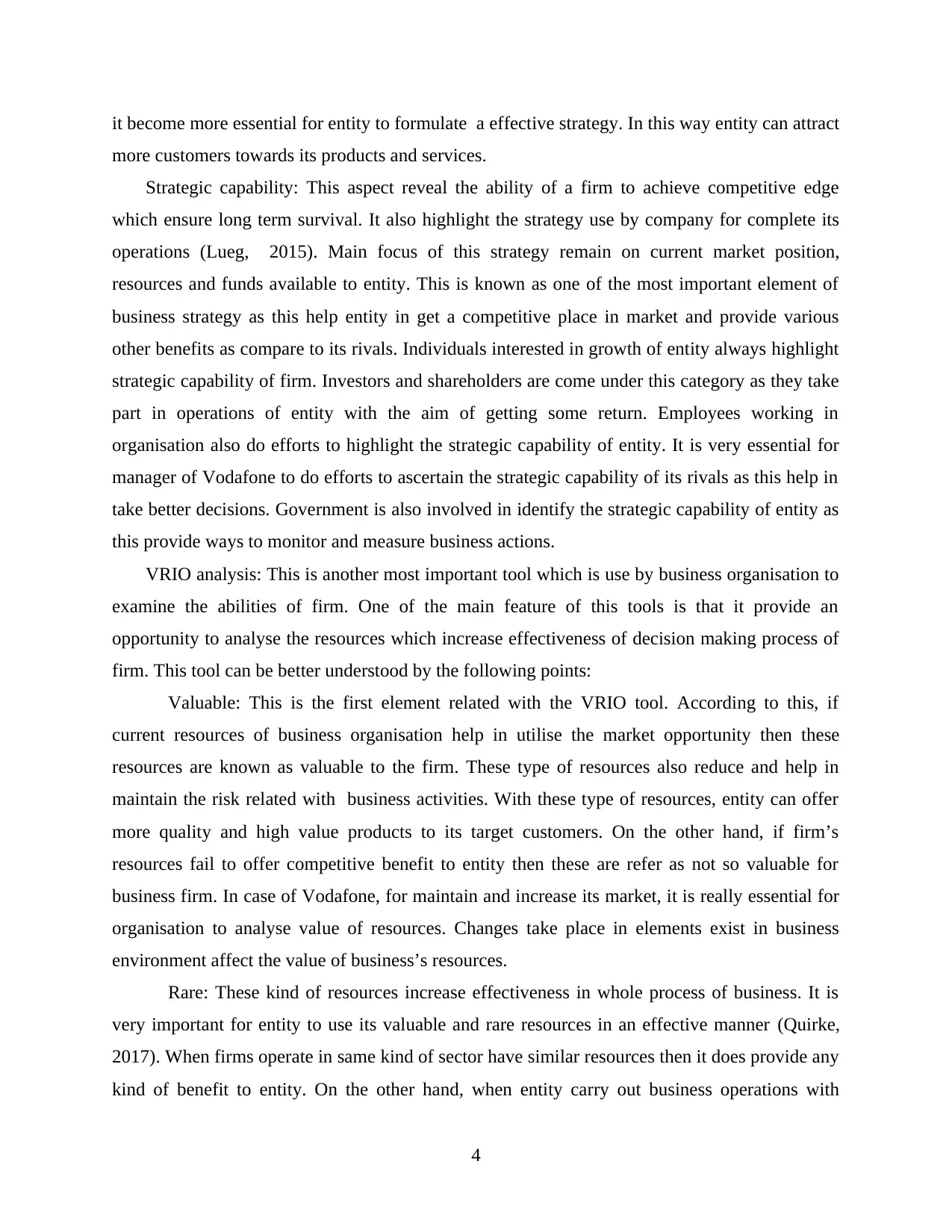
it become more essential for entity to formulate a effective strategy. In this way entity can attract
more customers towards its products and services.
Strategic capability: This aspect reveal the ability of a firm to achieve competitive edge
which ensure long term survival. It also highlight the strategy use by company for complete its
operations (Lueg, 2015). Main focus of this strategy remain on current market position,
resources and funds available to entity. This is known as one of the most important element of
business strategy as this help entity in get a competitive place in market and provide various
other benefits as compare to its rivals. Individuals interested in growth of entity always highlight
strategic capability of firm. Investors and shareholders are come under this category as they take
part in operations of entity with the aim of getting some return. Employees working in
organisation also do efforts to highlight the strategic capability of entity. It is very essential for
manager of Vodafone to do efforts to ascertain the strategic capability of its rivals as this help in
take better decisions. Government is also involved in identify the strategic capability of entity as
this provide ways to monitor and measure business actions.
VRIO analysis: This is another most important tool which is use by business organisation to
examine the abilities of firm. One of the main feature of this tools is that it provide an
opportunity to analyse the resources which increase effectiveness of decision making process of
firm. This tool can be better understood by the following points:
Valuable: This is the first element related with the VRIO tool. According to this, if
current resources of business organisation help in utilise the market opportunity then these
resources are known as valuable to the firm. These type of resources also reduce and help in
maintain the risk related with business activities. With these type of resources, entity can offer
more quality and high value products to its target customers. On the other hand, if firm’s
resources fail to offer competitive benefit to entity then these are refer as not so valuable for
business firm. In case of Vodafone, for maintain and increase its market, it is really essential for
organisation to analyse value of resources. Changes take place in elements exist in business
environment affect the value of business’s resources.
Rare: These kind of resources increase effectiveness in whole process of business. It is
very important for entity to use its valuable and rare resources in an effective manner (Quirke,
2017). When firms operate in same kind of sector have similar resources then it does provide any
kind of benefit to entity. On the other hand, when entity carry out business operations with
4
more customers towards its products and services.
Strategic capability: This aspect reveal the ability of a firm to achieve competitive edge
which ensure long term survival. It also highlight the strategy use by company for complete its
operations (Lueg, 2015). Main focus of this strategy remain on current market position,
resources and funds available to entity. This is known as one of the most important element of
business strategy as this help entity in get a competitive place in market and provide various
other benefits as compare to its rivals. Individuals interested in growth of entity always highlight
strategic capability of firm. Investors and shareholders are come under this category as they take
part in operations of entity with the aim of getting some return. Employees working in
organisation also do efforts to highlight the strategic capability of entity. It is very essential for
manager of Vodafone to do efforts to ascertain the strategic capability of its rivals as this help in
take better decisions. Government is also involved in identify the strategic capability of entity as
this provide ways to monitor and measure business actions.
VRIO analysis: This is another most important tool which is use by business organisation to
examine the abilities of firm. One of the main feature of this tools is that it provide an
opportunity to analyse the resources which increase effectiveness of decision making process of
firm. This tool can be better understood by the following points:
Valuable: This is the first element related with the VRIO tool. According to this, if
current resources of business organisation help in utilise the market opportunity then these
resources are known as valuable to the firm. These type of resources also reduce and help in
maintain the risk related with business activities. With these type of resources, entity can offer
more quality and high value products to its target customers. On the other hand, if firm’s
resources fail to offer competitive benefit to entity then these are refer as not so valuable for
business firm. In case of Vodafone, for maintain and increase its market, it is really essential for
organisation to analyse value of resources. Changes take place in elements exist in business
environment affect the value of business’s resources.
Rare: These kind of resources increase effectiveness in whole process of business. It is
very important for entity to use its valuable and rare resources in an effective manner (Quirke,
2017). When firms operate in same kind of sector have similar resources then it does provide any
kind of benefit to entity. On the other hand, when entity carry out business operations with
4
⊘ This is a preview!⊘
Do you want full access?
Subscribe today to unlock all pages.

Trusted by 1+ million students worldwide
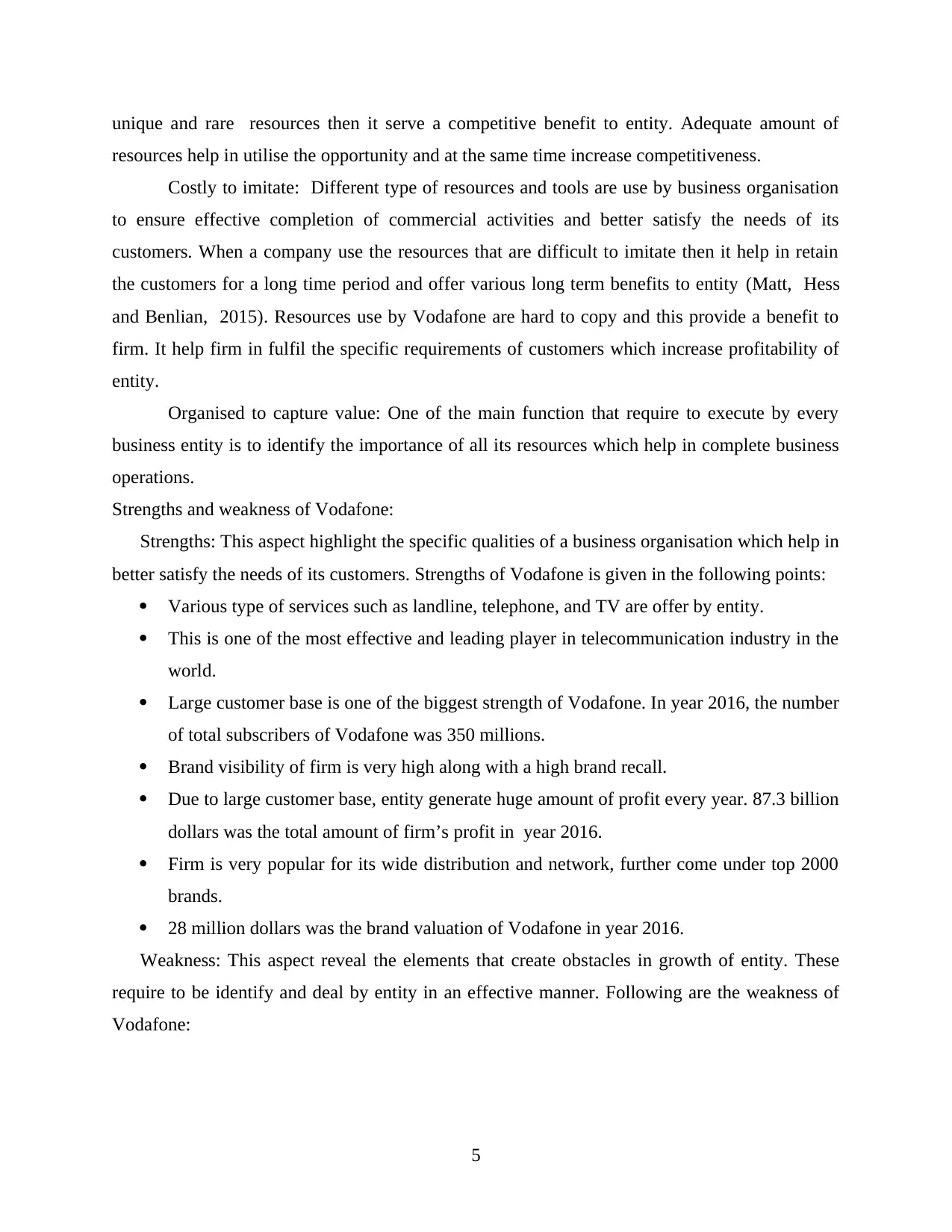
unique and rare resources then it serve a competitive benefit to entity. Adequate amount of
resources help in utilise the opportunity and at the same time increase competitiveness.
Costly to imitate: Different type of resources and tools are use by business organisation
to ensure effective completion of commercial activities and better satisfy the needs of its
customers. When a company use the resources that are difficult to imitate then it help in retain
the customers for a long time period and offer various long term benefits to entity (Matt, Hess
and Benlian, 2015). Resources use by Vodafone are hard to copy and this provide a benefit to
firm. It help firm in fulfil the specific requirements of customers which increase profitability of
entity.
Organised to capture value: One of the main function that require to execute by every
business entity is to identify the importance of all its resources which help in complete business
operations.
Strengths and weakness of Vodafone:
Strengths: This aspect highlight the specific qualities of a business organisation which help in
better satisfy the needs of its customers. Strengths of Vodafone is given in the following points:
Various type of services such as landline, telephone, and TV are offer by entity.
This is one of the most effective and leading player in telecommunication industry in the
world.
Large customer base is one of the biggest strength of Vodafone. In year 2016, the number
of total subscribers of Vodafone was 350 millions.
Brand visibility of firm is very high along with a high brand recall.
Due to large customer base, entity generate huge amount of profit every year. 87.3 billion
dollars was the total amount of firm’s profit in year 2016.
Firm is very popular for its wide distribution and network, further come under top 2000
brands.
28 million dollars was the brand valuation of Vodafone in year 2016.
Weakness: This aspect reveal the elements that create obstacles in growth of entity. These
require to be identify and deal by entity in an effective manner. Following are the weakness of
Vodafone:
5
resources help in utilise the opportunity and at the same time increase competitiveness.
Costly to imitate: Different type of resources and tools are use by business organisation
to ensure effective completion of commercial activities and better satisfy the needs of its
customers. When a company use the resources that are difficult to imitate then it help in retain
the customers for a long time period and offer various long term benefits to entity (Matt, Hess
and Benlian, 2015). Resources use by Vodafone are hard to copy and this provide a benefit to
firm. It help firm in fulfil the specific requirements of customers which increase profitability of
entity.
Organised to capture value: One of the main function that require to execute by every
business entity is to identify the importance of all its resources which help in complete business
operations.
Strengths and weakness of Vodafone:
Strengths: This aspect highlight the specific qualities of a business organisation which help in
better satisfy the needs of its customers. Strengths of Vodafone is given in the following points:
Various type of services such as landline, telephone, and TV are offer by entity.
This is one of the most effective and leading player in telecommunication industry in the
world.
Large customer base is one of the biggest strength of Vodafone. In year 2016, the number
of total subscribers of Vodafone was 350 millions.
Brand visibility of firm is very high along with a high brand recall.
Due to large customer base, entity generate huge amount of profit every year. 87.3 billion
dollars was the total amount of firm’s profit in year 2016.
Firm is very popular for its wide distribution and network, further come under top 2000
brands.
28 million dollars was the brand valuation of Vodafone in year 2016.
Weakness: This aspect reveal the elements that create obstacles in growth of entity. These
require to be identify and deal by entity in an effective manner. Following are the weakness of
Vodafone:
5
Paraphrase This Document
Need a fresh take? Get an instant paraphrase of this document with our AI Paraphraser
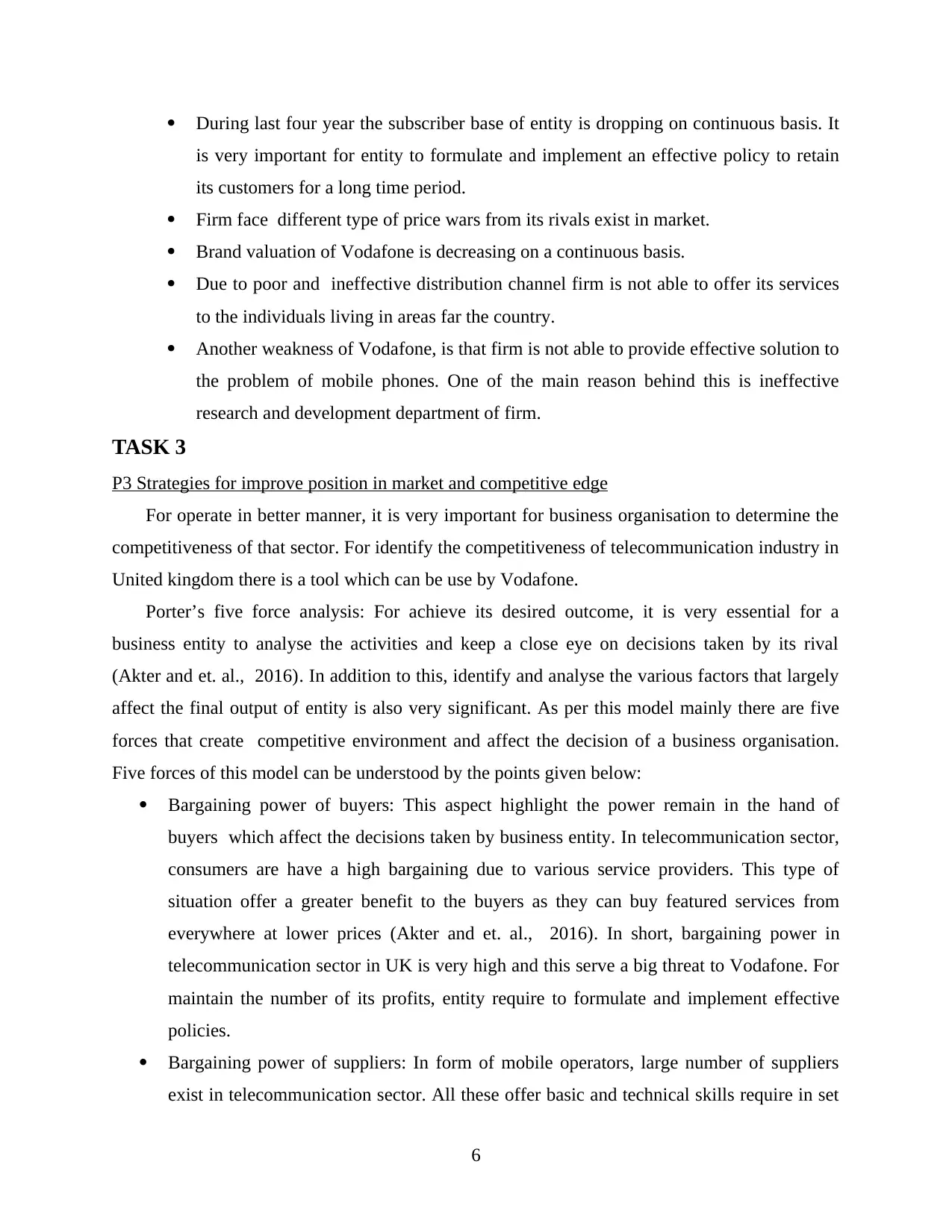
During last four year the subscriber base of entity is dropping on continuous basis. It
is very important for entity to formulate and implement an effective policy to retain
its customers for a long time period.
Firm face different type of price wars from its rivals exist in market.
Brand valuation of Vodafone is decreasing on a continuous basis.
Due to poor and ineffective distribution channel firm is not able to offer its services
to the individuals living in areas far the country.
Another weakness of Vodafone, is that firm is not able to provide effective solution to
the problem of mobile phones. One of the main reason behind this is ineffective
research and development department of firm.
TASK 3
P3 Strategies for improve position in market and competitive edge
For operate in better manner, it is very important for business organisation to determine the
competitiveness of that sector. For identify the competitiveness of telecommunication industry in
United kingdom there is a tool which can be use by Vodafone.
Porter’s five force analysis: For achieve its desired outcome, it is very essential for a
business entity to analyse the activities and keep a close eye on decisions taken by its rival
(Akter and et. al., 2016). In addition to this, identify and analyse the various factors that largely
affect the final output of entity is also very significant. As per this model mainly there are five
forces that create competitive environment and affect the decision of a business organisation.
Five forces of this model can be understood by the points given below:
Bargaining power of buyers: This aspect highlight the power remain in the hand of
buyers which affect the decisions taken by business entity. In telecommunication sector,
consumers are have a high bargaining due to various service providers. This type of
situation offer a greater benefit to the buyers as they can buy featured services from
everywhere at lower prices (Akter and et. al., 2016). In short, bargaining power in
telecommunication sector in UK is very high and this serve a big threat to Vodafone. For
maintain the number of its profits, entity require to formulate and implement effective
policies.
Bargaining power of suppliers: In form of mobile operators, large number of suppliers
exist in telecommunication sector. All these offer basic and technical skills require in set
6
is very important for entity to formulate and implement an effective policy to retain
its customers for a long time period.
Firm face different type of price wars from its rivals exist in market.
Brand valuation of Vodafone is decreasing on a continuous basis.
Due to poor and ineffective distribution channel firm is not able to offer its services
to the individuals living in areas far the country.
Another weakness of Vodafone, is that firm is not able to provide effective solution to
the problem of mobile phones. One of the main reason behind this is ineffective
research and development department of firm.
TASK 3
P3 Strategies for improve position in market and competitive edge
For operate in better manner, it is very important for business organisation to determine the
competitiveness of that sector. For identify the competitiveness of telecommunication industry in
United kingdom there is a tool which can be use by Vodafone.
Porter’s five force analysis: For achieve its desired outcome, it is very essential for a
business entity to analyse the activities and keep a close eye on decisions taken by its rival
(Akter and et. al., 2016). In addition to this, identify and analyse the various factors that largely
affect the final output of entity is also very significant. As per this model mainly there are five
forces that create competitive environment and affect the decision of a business organisation.
Five forces of this model can be understood by the points given below:
Bargaining power of buyers: This aspect highlight the power remain in the hand of
buyers which affect the decisions taken by business entity. In telecommunication sector,
consumers are have a high bargaining due to various service providers. This type of
situation offer a greater benefit to the buyers as they can buy featured services from
everywhere at lower prices (Akter and et. al., 2016). In short, bargaining power in
telecommunication sector in UK is very high and this serve a big threat to Vodafone. For
maintain the number of its profits, entity require to formulate and implement effective
policies.
Bargaining power of suppliers: In form of mobile operators, large number of suppliers
exist in telecommunication sector. All these offer basic and technical skills require in set
6
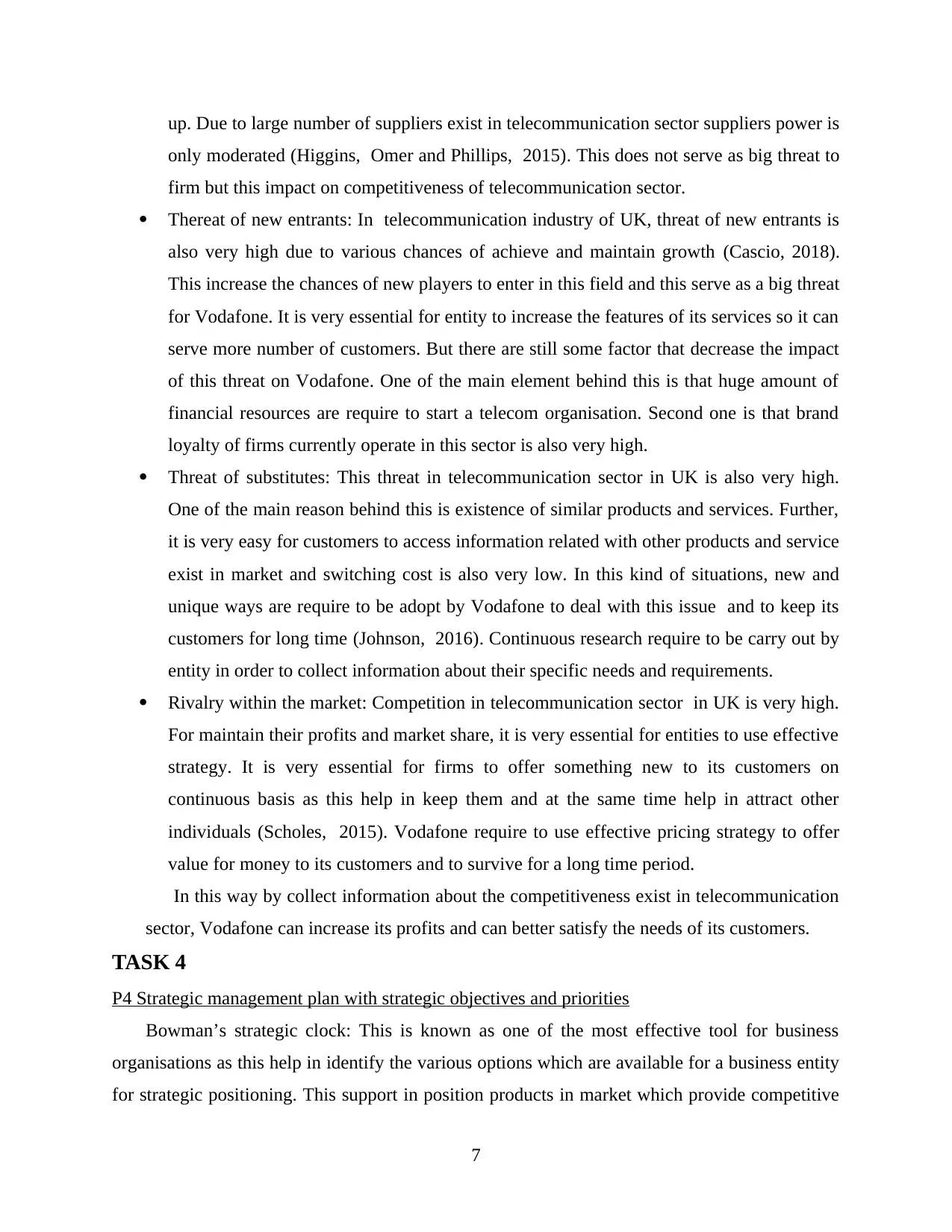
up. Due to large number of suppliers exist in telecommunication sector suppliers power is
only moderated (Higgins, Omer and Phillips, 2015). This does not serve as big threat to
firm but this impact on competitiveness of telecommunication sector.
Thereat of new entrants: In telecommunication industry of UK, threat of new entrants is
also very high due to various chances of achieve and maintain growth (Cascio, 2018).
This increase the chances of new players to enter in this field and this serve as a big threat
for Vodafone. It is very essential for entity to increase the features of its services so it can
serve more number of customers. But there are still some factor that decrease the impact
of this threat on Vodafone. One of the main element behind this is that huge amount of
financial resources are require to start a telecom organisation. Second one is that brand
loyalty of firms currently operate in this sector is also very high.
Threat of substitutes: This threat in telecommunication sector in UK is also very high.
One of the main reason behind this is existence of similar products and services. Further,
it is very easy for customers to access information related with other products and service
exist in market and switching cost is also very low. In this kind of situations, new and
unique ways are require to be adopt by Vodafone to deal with this issue and to keep its
customers for long time (Johnson, 2016). Continuous research require to be carry out by
entity in order to collect information about their specific needs and requirements.
Rivalry within the market: Competition in telecommunication sector in UK is very high.
For maintain their profits and market share, it is very essential for entities to use effective
strategy. It is very essential for firms to offer something new to its customers on
continuous basis as this help in keep them and at the same time help in attract other
individuals (Scholes, 2015). Vodafone require to use effective pricing strategy to offer
value for money to its customers and to survive for a long time period.
In this way by collect information about the competitiveness exist in telecommunication
sector, Vodafone can increase its profits and can better satisfy the needs of its customers.
TASK 4
P4 Strategic management plan with strategic objectives and priorities
Bowman’s strategic clock: This is known as one of the most effective tool for business
organisations as this help in identify the various options which are available for a business entity
for strategic positioning. This support in position products in market which provide competitive
7
only moderated (Higgins, Omer and Phillips, 2015). This does not serve as big threat to
firm but this impact on competitiveness of telecommunication sector.
Thereat of new entrants: In telecommunication industry of UK, threat of new entrants is
also very high due to various chances of achieve and maintain growth (Cascio, 2018).
This increase the chances of new players to enter in this field and this serve as a big threat
for Vodafone. It is very essential for entity to increase the features of its services so it can
serve more number of customers. But there are still some factor that decrease the impact
of this threat on Vodafone. One of the main element behind this is that huge amount of
financial resources are require to start a telecom organisation. Second one is that brand
loyalty of firms currently operate in this sector is also very high.
Threat of substitutes: This threat in telecommunication sector in UK is also very high.
One of the main reason behind this is existence of similar products and services. Further,
it is very easy for customers to access information related with other products and service
exist in market and switching cost is also very low. In this kind of situations, new and
unique ways are require to be adopt by Vodafone to deal with this issue and to keep its
customers for long time (Johnson, 2016). Continuous research require to be carry out by
entity in order to collect information about their specific needs and requirements.
Rivalry within the market: Competition in telecommunication sector in UK is very high.
For maintain their profits and market share, it is very essential for entities to use effective
strategy. It is very essential for firms to offer something new to its customers on
continuous basis as this help in keep them and at the same time help in attract other
individuals (Scholes, 2015). Vodafone require to use effective pricing strategy to offer
value for money to its customers and to survive for a long time period.
In this way by collect information about the competitiveness exist in telecommunication
sector, Vodafone can increase its profits and can better satisfy the needs of its customers.
TASK 4
P4 Strategic management plan with strategic objectives and priorities
Bowman’s strategic clock: This is known as one of the most effective tool for business
organisations as this help in identify the various options which are available for a business entity
for strategic positioning. This support in position products in market which provide competitive
7
⊘ This is a preview!⊘
Do you want full access?
Subscribe today to unlock all pages.

Trusted by 1+ million students worldwide
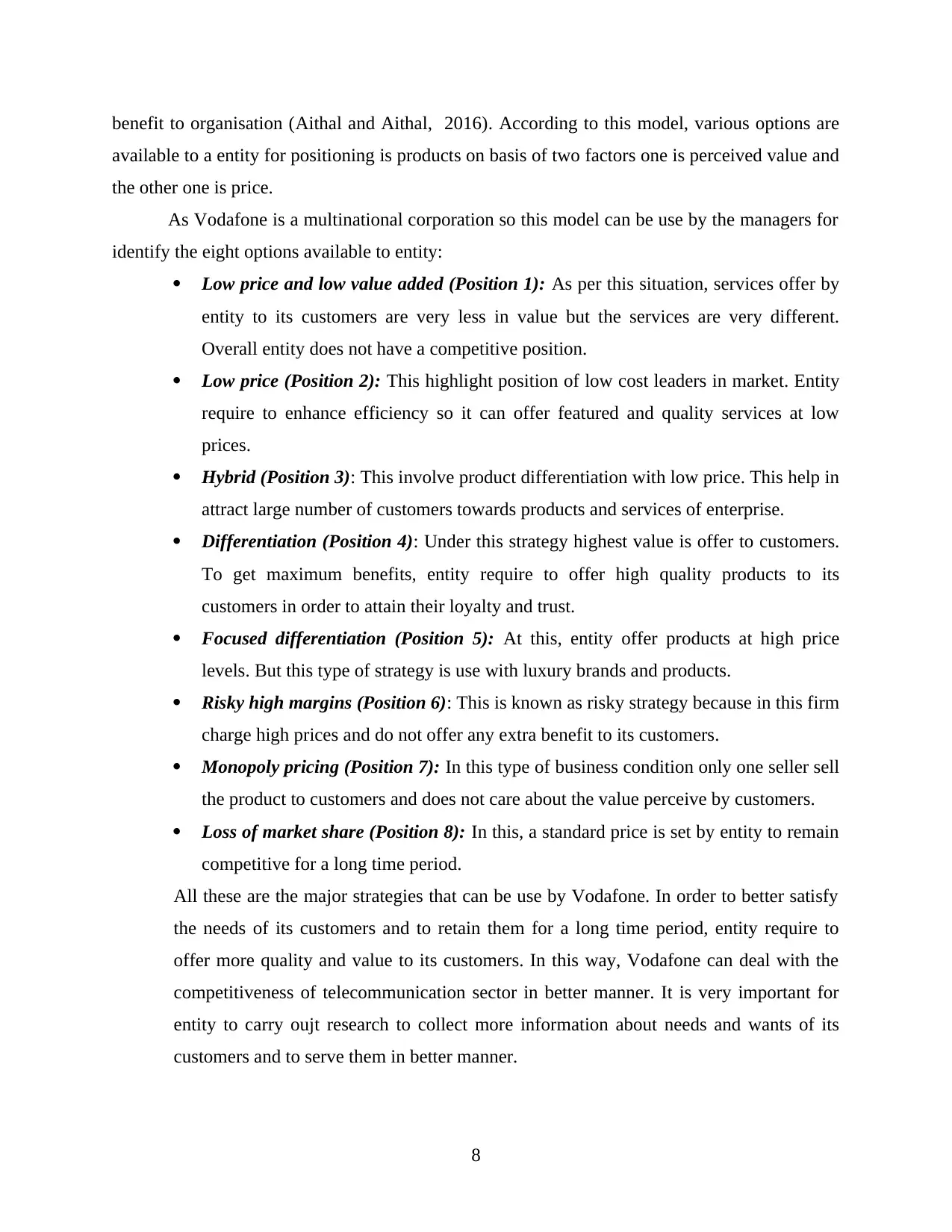
benefit to organisation (Aithal and Aithal, 2016). According to this model, various options are
available to a entity for positioning is products on basis of two factors one is perceived value and
the other one is price.
As Vodafone is a multinational corporation so this model can be use by the managers for
identify the eight options available to entity:
Low price and low value added (Position 1): As per this situation, services offer by
entity to its customers are very less in value but the services are very different.
Overall entity does not have a competitive position.
Low price (Position 2): This highlight position of low cost leaders in market. Entity
require to enhance efficiency so it can offer featured and quality services at low
prices.
Hybrid (Position 3): This involve product differentiation with low price. This help in
attract large number of customers towards products and services of enterprise.
Differentiation (Position 4): Under this strategy highest value is offer to customers.
To get maximum benefits, entity require to offer high quality products to its
customers in order to attain their loyalty and trust.
Focused differentiation (Position 5): At this, entity offer products at high price
levels. But this type of strategy is use with luxury brands and products.
Risky high margins (Position 6): This is known as risky strategy because in this firm
charge high prices and do not offer any extra benefit to its customers.
Monopoly pricing (Position 7): In this type of business condition only one seller sell
the product to customers and does not care about the value perceive by customers.
Loss of market share (Position 8): In this, a standard price is set by entity to remain
competitive for a long time period.
All these are the major strategies that can be use by Vodafone. In order to better satisfy
the needs of its customers and to retain them for a long time period, entity require to
offer more quality and value to its customers. In this way, Vodafone can deal with the
competitiveness of telecommunication sector in better manner. It is very important for
entity to carry oujt research to collect more information about needs and wants of its
customers and to serve them in better manner.
8
available to a entity for positioning is products on basis of two factors one is perceived value and
the other one is price.
As Vodafone is a multinational corporation so this model can be use by the managers for
identify the eight options available to entity:
Low price and low value added (Position 1): As per this situation, services offer by
entity to its customers are very less in value but the services are very different.
Overall entity does not have a competitive position.
Low price (Position 2): This highlight position of low cost leaders in market. Entity
require to enhance efficiency so it can offer featured and quality services at low
prices.
Hybrid (Position 3): This involve product differentiation with low price. This help in
attract large number of customers towards products and services of enterprise.
Differentiation (Position 4): Under this strategy highest value is offer to customers.
To get maximum benefits, entity require to offer high quality products to its
customers in order to attain their loyalty and trust.
Focused differentiation (Position 5): At this, entity offer products at high price
levels. But this type of strategy is use with luxury brands and products.
Risky high margins (Position 6): This is known as risky strategy because in this firm
charge high prices and do not offer any extra benefit to its customers.
Monopoly pricing (Position 7): In this type of business condition only one seller sell
the product to customers and does not care about the value perceive by customers.
Loss of market share (Position 8): In this, a standard price is set by entity to remain
competitive for a long time period.
All these are the major strategies that can be use by Vodafone. In order to better satisfy
the needs of its customers and to retain them for a long time period, entity require to
offer more quality and value to its customers. In this way, Vodafone can deal with the
competitiveness of telecommunication sector in better manner. It is very important for
entity to carry oujt research to collect more information about needs and wants of its
customers and to serve them in better manner.
8
Paraphrase This Document
Need a fresh take? Get an instant paraphrase of this document with our AI Paraphraser
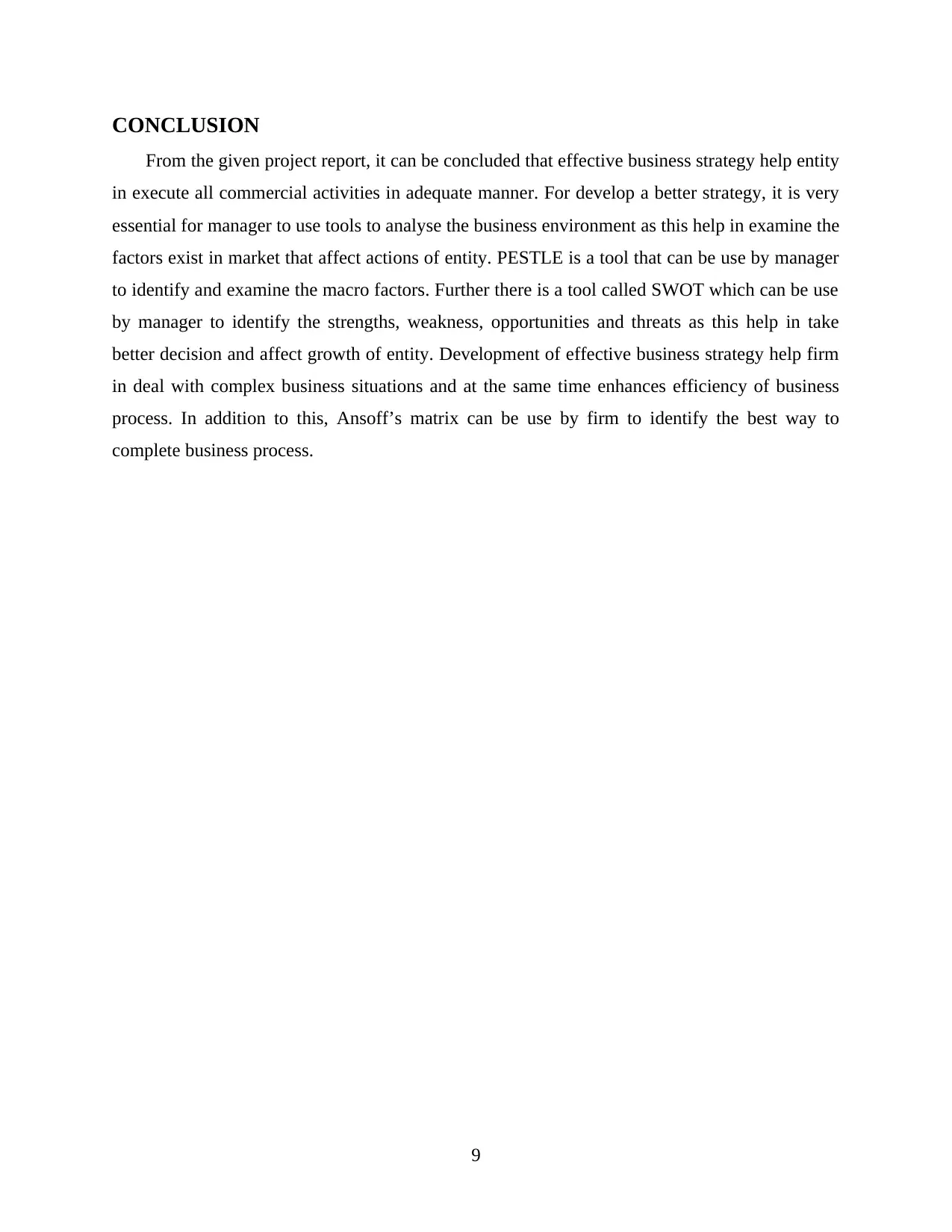
CONCLUSION
From the given project report, it can be concluded that effective business strategy help entity
in execute all commercial activities in adequate manner. For develop a better strategy, it is very
essential for manager to use tools to analyse the business environment as this help in examine the
factors exist in market that affect actions of entity. PESTLE is a tool that can be use by manager
to identify and examine the macro factors. Further there is a tool called SWOT which can be use
by manager to identify the strengths, weakness, opportunities and threats as this help in take
better decision and affect growth of entity. Development of effective business strategy help firm
in deal with complex business situations and at the same time enhances efficiency of business
process. In addition to this, Ansoff’s matrix can be use by firm to identify the best way to
complete business process.
9
From the given project report, it can be concluded that effective business strategy help entity
in execute all commercial activities in adequate manner. For develop a better strategy, it is very
essential for manager to use tools to analyse the business environment as this help in examine the
factors exist in market that affect actions of entity. PESTLE is a tool that can be use by manager
to identify and examine the macro factors. Further there is a tool called SWOT which can be use
by manager to identify the strengths, weakness, opportunities and threats as this help in take
better decision and affect growth of entity. Development of effective business strategy help firm
in deal with complex business situations and at the same time enhances efficiency of business
process. In addition to this, Ansoff’s matrix can be use by firm to identify the best way to
complete business process.
9
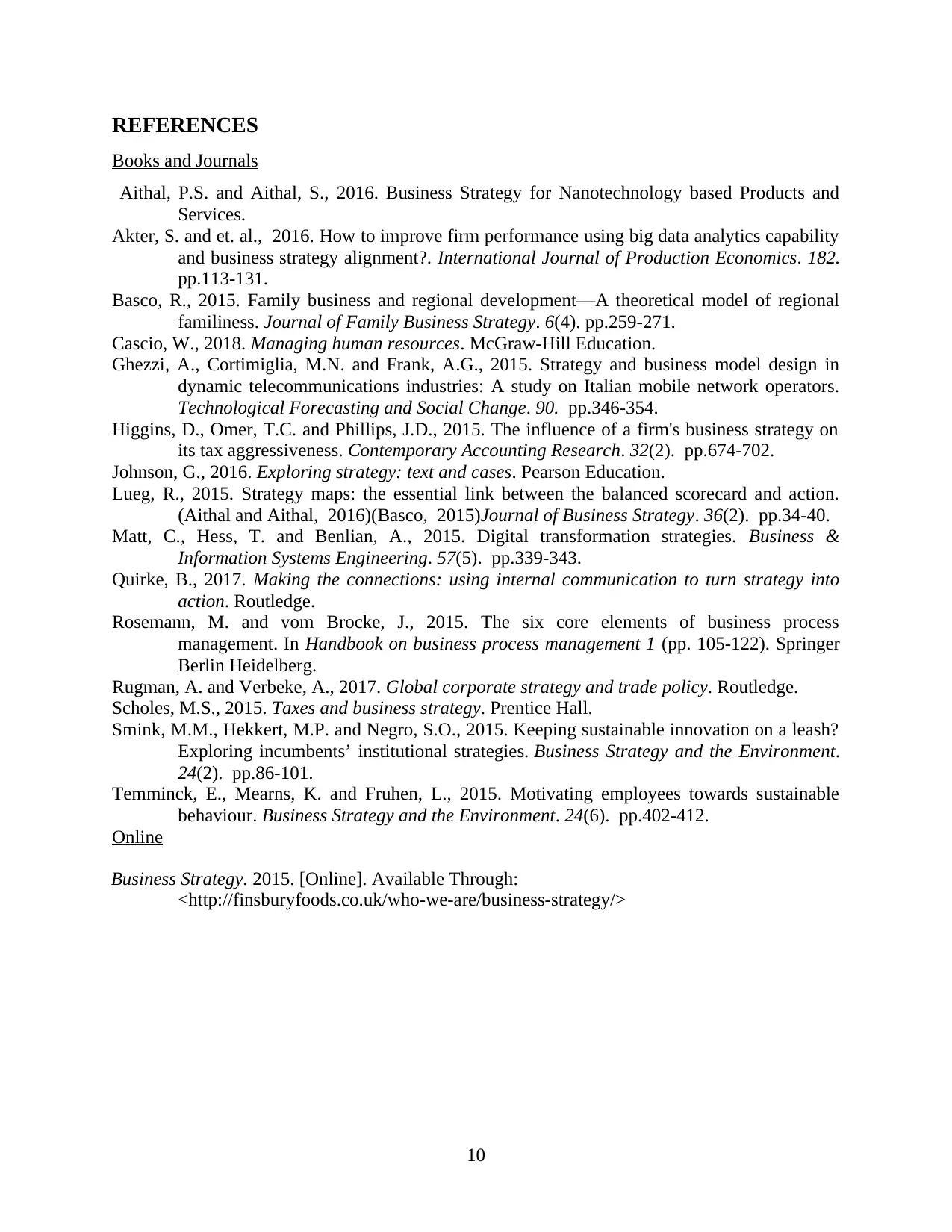
REFERENCES
Books and Journals
Aithal, P.S. and Aithal, S., 2016. Business Strategy for Nanotechnology based Products and
Services.
Akter, S. and et. al., 2016. How to improve firm performance using big data analytics capability
and business strategy alignment?. International Journal of Production Economics. 182.
pp.113-131.
Basco, R., 2015. Family business and regional development—A theoretical model of regional
familiness. Journal of Family Business Strategy. 6(4). pp.259-271.
Cascio, W., 2018. Managing human resources. McGraw-Hill Education.
Ghezzi, A., Cortimiglia, M.N. and Frank, A.G., 2015. Strategy and business model design in
dynamic telecommunications industries: A study on Italian mobile network operators.
Technological Forecasting and Social Change. 90. pp.346-354.
Higgins, D., Omer, T.C. and Phillips, J.D., 2015. The influence of a firm's business strategy on
its tax aggressiveness. Contemporary Accounting Research. 32(2). pp.674-702.
Johnson, G., 2016. Exploring strategy: text and cases. Pearson Education.
Lueg, R., 2015. Strategy maps: the essential link between the balanced scorecard and action.
(Aithal and Aithal, 2016)(Basco, 2015)Journal of Business Strategy. 36(2). pp.34-40.
Matt, C., Hess, T. and Benlian, A., 2015. Digital transformation strategies. Business &
Information Systems Engineering. 57(5). pp.339-343.
Quirke, B., 2017. Making the connections: using internal communication to turn strategy into
action. Routledge.
Rosemann, M. and vom Brocke, J., 2015. The six core elements of business process
management. In Handbook on business process management 1 (pp. 105-122). Springer
Berlin Heidelberg.
Rugman, A. and Verbeke, A., 2017. Global corporate strategy and trade policy. Routledge.
Scholes, M.S., 2015. Taxes and business strategy. Prentice Hall.
Smink, M.M., Hekkert, M.P. and Negro, S.O., 2015. Keeping sustainable innovation on a leash?
Exploring incumbents’ institutional strategies. Business Strategy and the Environment.
24(2). pp.86-101.
Temminck, E., Mearns, K. and Fruhen, L., 2015. Motivating employees towards sustainable
behaviour. Business Strategy and the Environment. 24(6). pp.402-412.
Online
Business Strategy. 2015. [Online]. Available Through:
<http://finsburyfoods.co.uk/who-we-are/business-strategy/>
10
Books and Journals
Aithal, P.S. and Aithal, S., 2016. Business Strategy for Nanotechnology based Products and
Services.
Akter, S. and et. al., 2016. How to improve firm performance using big data analytics capability
and business strategy alignment?. International Journal of Production Economics. 182.
pp.113-131.
Basco, R., 2015. Family business and regional development—A theoretical model of regional
familiness. Journal of Family Business Strategy. 6(4). pp.259-271.
Cascio, W., 2018. Managing human resources. McGraw-Hill Education.
Ghezzi, A., Cortimiglia, M.N. and Frank, A.G., 2015. Strategy and business model design in
dynamic telecommunications industries: A study on Italian mobile network operators.
Technological Forecasting and Social Change. 90. pp.346-354.
Higgins, D., Omer, T.C. and Phillips, J.D., 2015. The influence of a firm's business strategy on
its tax aggressiveness. Contemporary Accounting Research. 32(2). pp.674-702.
Johnson, G., 2016. Exploring strategy: text and cases. Pearson Education.
Lueg, R., 2015. Strategy maps: the essential link between the balanced scorecard and action.
(Aithal and Aithal, 2016)(Basco, 2015)Journal of Business Strategy. 36(2). pp.34-40.
Matt, C., Hess, T. and Benlian, A., 2015. Digital transformation strategies. Business &
Information Systems Engineering. 57(5). pp.339-343.
Quirke, B., 2017. Making the connections: using internal communication to turn strategy into
action. Routledge.
Rosemann, M. and vom Brocke, J., 2015. The six core elements of business process
management. In Handbook on business process management 1 (pp. 105-122). Springer
Berlin Heidelberg.
Rugman, A. and Verbeke, A., 2017. Global corporate strategy and trade policy. Routledge.
Scholes, M.S., 2015. Taxes and business strategy. Prentice Hall.
Smink, M.M., Hekkert, M.P. and Negro, S.O., 2015. Keeping sustainable innovation on a leash?
Exploring incumbents’ institutional strategies. Business Strategy and the Environment.
24(2). pp.86-101.
Temminck, E., Mearns, K. and Fruhen, L., 2015. Motivating employees towards sustainable
behaviour. Business Strategy and the Environment. 24(6). pp.402-412.
Online
Business Strategy. 2015. [Online]. Available Through:
<http://finsburyfoods.co.uk/who-we-are/business-strategy/>
10
⊘ This is a preview!⊘
Do you want full access?
Subscribe today to unlock all pages.

Trusted by 1+ million students worldwide
1 out of 12
Related Documents
Your All-in-One AI-Powered Toolkit for Academic Success.
+13062052269
info@desklib.com
Available 24*7 on WhatsApp / Email
![[object Object]](/_next/static/media/star-bottom.7253800d.svg)
Unlock your academic potential
Copyright © 2020–2025 A2Z Services. All Rights Reserved. Developed and managed by ZUCOL.





